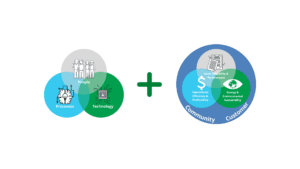According to Statista, corporate spending on digital transformation is projected to reach U.S. $1.8 trillion in 2022 and, by 2025, to reach $2.8 trillion. Yet for all the corporate enthusiasm in launching digital transformation projects, investment payback can often be elusive. Key challenges that can limit the ability to convert digital transformation investments into innovation and competitive advantage include a focus on technology instead of on people and an inability to break through corporate silo constraints.

Agile design thinking aids digital transformation
New ways of applying methodologies such as agile design thinking are now helping industrial organizations to overcome such obstacles. The agile design thinking framework goes beyond just looking at technical specifications. Instead, emphasis is placed on involving “bottom-up” business- process experts, at all levels of the organization, in a collaborative effort to define problem statements and to design appropriate solutions.

Such an approach was applied internally at Schneider Electric in one of our Indonesian factories. By working directly with plant workers, transformation goals were established that included improved work quality (allowing people to execute their work more simply) and faster and more accurate decision-making. We talked not only with management, but also with groups of operators, maintenance technicians, and engineers. [Tweet “Our goal was to gather their inputs regarding how to improve workflow and ensure they came away with the belief that ‘’digital can help make YOUR life easier.””] Our goal was to gather their inputs regarding how to improve workflow and ensure they came away with the belief that ‘’digital can help make YOUR life easier.” We focused on changing mindsets and breaking down workplace silos to empower shop floor personnel to work smarter and easier. This approach highlighted the strengths of the collective organization, as opposed to just a few in management, to maximize the impact of digital transformation.
After this initial discovery phase, solutions were configured that provided advanced visibility into operations, maintenance, and energy use. As a direct result of these efforts, maintenance costs have been reduced while overall equipment efficiency (OEE) has increased. The factory has reported a 44% reduction in machine downtime over the last year.
3 keys for achieving pervasive, scalable digital transformation
When entering into engagements with perspective clients, we discover that most companies unknowingly limit their digital transformation success when they fail to involve operation-level workers in their planning. With clients who wish to maximize the return from their digital transformation investments, we emphasize three steps that are critical to overall success:
-
Modification of traditional solution acquisition approaches – Many organizations focus on just the physical, technical aspect of a digital transformation solution. They typically write an RFQ around that perceived solution. Instead, before issuing the RFQ, we recommend involving people beyond only technology design engineers. We shift the focus to people who will be using the product directly. Their viewpoints on how to eliminate paper processes and boost manufacturing line efficiencies offer a much more holistic view for digital transformation than does the traditional RFQ.
-
Nurturing of change agents – People at the operational level need to be encouraged to not wait for directives from management to implement digital transformation. Moreover, for these initiatives to be successful, breaking down silos must become part of an obsession for change across all departments. This means giving workers the freedom to develop organically as champions and to co-create with their intra-departmental peers. If properly executed, the right environment can be created that nurtures internal change agents who can formulate a more holistic vision of digital transformation. In this way, the solution can positively impact both upstream and downstream departments.
-
Descriptions of an exceptional world – Discussions among workers, operators, and engineers should involve sharing visions about what digital transformation can be in an exceptional world and include descriptions of what that “to be” world would look like. This helps to reveal what workers aspire to achieve if provided the right productivity tools. This feedback serves as excellent material for formulating solution specifications and ensures buy-in from anybody who may be interacting with the solution, once it’s implemented.
Increased agility with top-down and bottom-up-driven transformation initiatives
Digital transformation is about holistic thinking and optimizing processes by having the right data at the right time to make better decisions. Traditionally, most of these projects have been implemented from the top down. But in today’s world where communications within organizations are based on highly matrixed networking, it makes sense for digital transformation projects to also be initiated from the bottom up. With more people involved in the front end of the planning, not only do digital transformation projects become more scalable, but also an agile design thinking methodology can be nurtured that focuses on stronger value creation for peers, partners, and customers.
For more information
To learn more about how your company can embrace digital transformation, contact our Digital Transformation Consultants Rik De Smet, Rob Veldhoen, and Ashley Thomas Philip.
CNN Indonesia published a Digital Transformation article co-authored by Rik de Smet and Farid Belbouab, CEO of shipping company Meratus. Read the English version here.


